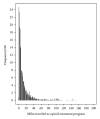Distance traveled and cross-state commuting to opioid treatment programs in the United States
- PMID: 21776440
- PMCID: PMC3136171
- DOI: 10.1155/2011/948789
Distance traveled and cross-state commuting to opioid treatment programs in the United States
Abstract
This study examined commuting patterns among 23,141 methadone patients enrolling in 84 opioid treatment programs (OTPs) in the United States. Patients completed an anonymous one-page survey. A linear mixed model analysis was used to predict distance traveled to the OTP. More than half (60%) the patients traveled < 10 miles and 6% travelled between 50 and 200 miles to attend an OTP; 8% travelled across a state border to attend an OTP. In the multivariate model (n = 17,792), factors significantly (P < .05) associated with distance were, residing in the Southeast or Midwest, low urbanicity, area of the patient's ZIP code, younger age, non-Hispanic white race/ethnicity, prescription opioid abuse, and no heroin use. A significant number of OTP patients travel considerable distances to access treatment. To reduce obstacles to OTP access, policy makers and treatment providers should be alert to patients' commuting patterns and to factors associated with them.
Figures


References
-
- Billi JE, Pai CW, Spahlinger DA. The effect of distance to primary care physician on health care utilization and disease burden. Health Care Management Review. 2007;32(1):22–29. - PubMed
-
- Beardsley K, Wish ED, Fitzelle DB, O’Grady K, Arria AM. Distance traveled to outpatient drug treatment and client retention. Journal of Substance Abuse Treatment. 2003;25(4):279–285. - PubMed
-
- Schmitt SK, Phibbs CS, Piette JD. The influence of distance on utilization of outpatient mental health aftercare following inpatient substance abuse treatment. Addictive Behaviors. 2003;28(6):1183–1192. - PubMed
-
- Magura S, Rosenblum A. Leaving methadone treatment: lessons learned, lessons forgotten, lessons ignored. Mount Sinai Journal of Medicine. 2001;68(1):62–74. - PubMed
-
- Simpson DD, Joe GW, Brown BS. Treatment retention and follow-up outcomes in the drug abuse treatment outcome study (DATOS) Psychology of Addictive Behaviors. 1997;11(4):294–307.
Publication types
MeSH terms
Substances
LinkOut - more resources
Full Text Sources
Medical

